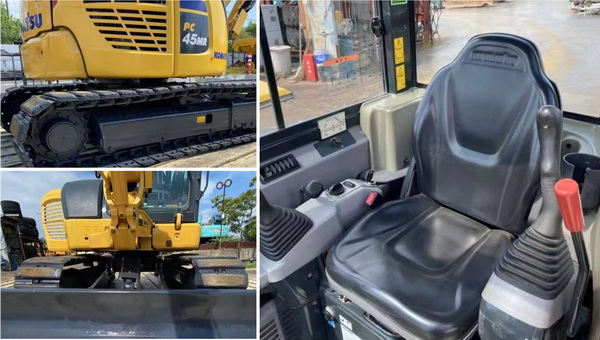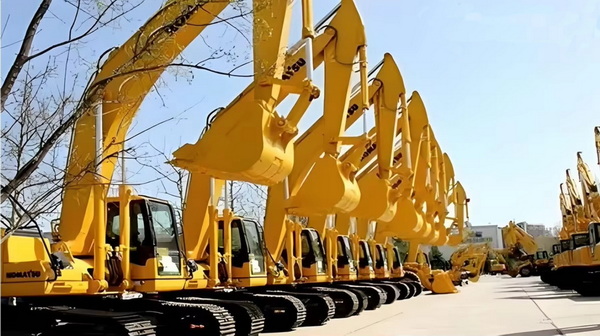Views: 222 Author: Amanda Publish Time: 2025-11-13 Origin: Site








Content Menu
● Understanding Excavator Size Categories
● Key Factors Influencing Excavator Size Choice
>> Lifting and Load Requirements
>> Mini and Compact Excavators
● Practical Example: Matching Excavator Size to Common Jobs
● Used Excavator Selection: Advantages and Key Considerations
>> Benefits of Purchasing a Used Excavator
>> Inspection Checklist for Used Excavators
● Maximizing Value from a Used Excavator
>> Usage History and Service Documentation
● Sizing Tips for Specialized Applications
● Common Mistakes When Selecting Used Excavator Sizes
● Frequently Overlooked Details
● Key Trends in Excavator Design and Used Market
● FAQ
>> 1. Why should I buy a Used Excavator instead of new?
>> 2. How do I determine the suitable size for my Used Excavator?
>> 3. What inspection steps are essential before buying a Used Excavator?
>> 4. Can a Used Excavator be reliably used for heavy-duty projects?
>> 5. Which brands hold the best value in the Used Excavator market?
Selecting the right size for a Used Excavator is a pivotal decision for professionals in construction, landscaping, and infrastructure development. The process involves more than just matching performance statistics to a job—it demands a careful assessment of site constraints, project goals, and operational efficiency. This comprehensive guide will take you through the nuances of Used Excavator size selection, the factors at play, and how to make practical choices for both new and experienced buyers. The information below incorporates industry best practices, advice from specialists, and the most recent advancements in excavator technology to ensure your projects are efficient, safe, and profitable.[2][10][11]

Excavators are categorized primarily by their operating weight:
| Excavator Size | Weight Range | Typical Applications |
|---|---|---|
| Mini | 1–7 tons | Residential work, landscaping, tight spaces |
| Small | 7–20 tons | Utility, commercial, and urban environments |
| Medium | 20–35 tons | Construction, infrastructure, general job sites |
| Large | 35+ tons | Mining, major earthworks, heavy-duty construction |
Understanding these categories helps determine which class of Used Excavator fits your project best, balancing power, maneuverability, and operating costs.[4][7]
Assess the exact requirements: Are you trenching for utility work, preparing a home site, or handling large-scale road construction? For instance, a Used Excavator in the mini-class is ideal for tight, urban projects, while large excavators are suited for major earthmoving and mining.[5][8]
Your project may demand a specific dig depth or horizontal reach. For foundation work or basement jobs, a medium to large Used Excavator may be necessary; landscaping and pool installations are often perfect matches for mini or small units.[6][7]
Heavier materials and attachments require higher lifting capacities. Always check the operating weight and loading capabilities of the Used Excavator under consideration.[8][2]
Urban and confined sites benefit from compact designs; rough or unstable terrain favors larger undercarriage footprints for stability.
Hydraulic flow, auxiliary lines, and mounting systems on the Used Excavator should match your intended accessories—buckets, augers, grapples, and more.[2][6]
Smaller Used Excavators are easier and cheaper to transport, which can be a critical cost factor for small businesses and frequent job changes.
These are versatile and stable on uneven ground, making them the top choice for rough terrain and major excavation.
Wheeled versions excel in areas requiring frequent relocation or asphalt surfaces, such as municipal road work.
Essential in demolition and dredging, these units provide a greater reach without sacrificing stability.
Designed specifically for tight-access projects, urban landscaping, and maintenance, these Used Excavators are highly popular with utility contractors and private builders.[6][2]

- Residential foundation excavation: Mini or small Used Excavator.
- Road or utility construction: Medium Used Excavator, balancing power and access.
- Mining, heavy infrastructure: Large Used Excavator for major digging and lifting.
Contractors consistently benefit by carefully matching size to specific project scenarios to avoid underusing or over-investing in a Used Excavator.[5][8]
- Cost Efficiency: Significant acquisition cost savings, leaving more funds for other project investments.
- Lower Depreciation: The Used Excavator has already absorbed most initial value loss.
- Immediate Availability: Many Used Excavator models are ready for use, eliminating long lead times.
- Proven Performance: You can research operational records and maintenance histories, ensuring reliability.[12][13]
1. Hydraulic Functionality: Look for leaks, proper hose routing, and wear on cylinders.
2. Undercarriage and Tracks: Typically account for a major share of upkeep—inspect meticulously.
3. Attachment Wear: Worn-out buckets, couplers, and quick-connects may lead to costly repairs.
4. Engine Health: Analyze exhaust, listen for unusual noises, and check service records.
5. Operator Controls and Electronics: Confirm all controls respond accurately and display panels work.
6. Structural Condition: Inspect booms, arms, and mainframes for cracks or rewelded areas.[13][14][15]
Purchasing from reputable suppliers, like KeyChain Venture Co., Ltd., ensures greater trust and after-sales support with any Used Excavator.
Ask for a comprehensive (and verifiable) service history. Units maintained by a single owner and those with less intensive job logs generally offer greater value.
Used Excavators coming off reputable rental fleets often undergo high-quality, routine servicing and make excellent choices.[15][13]
Whenever possible, select Used Excavators that are sold with some form of transferable warranty or ongoing support agreement.
Mini and compact Used Excavators (1–7 tons) excel here. Their short tailswing and lightweight frames minimize collateral damage to nearby structures and landscaping.
Medium to large Used Excavators with extended boom configurations are optimal, especially for foundation and drainage work.
Standard and large Used Excavators can work alongside heavy trucks and loaders, aiding in both earthmoving and material handling.[8][2]
- Choosing too small: This results in longer project times, higher fuel costs per cubic meter, and unexpected breakdowns.
- Choosing too large: Transport costs spike and the machine may damage existing surfaces or landscaping on smaller sites.
- Ignoring attachment needs: Not all models can safely support every attachment—verify before purchasing your Used Excavator.
- Auxiliary Hydraulics: For job sites relying on work tools, make sure the Used Excavator's hydraulic output is sufficient.
- Cab Comfort: Operator comfort directly impacts productivity—test the seats, controls, and climate control during inspection.
- Resale Value: Premium brands with documentation (like Caterpillar, Volvo, SANY) command higher resale values—a major bonus for Used Excavator buyers.
The rise of hybrid and electric drive systems in Used Excavators is meeting demand for lower emissions and greater fuel efficiency in urban projects. Buyers also increasingly seek machines with digital monitoring, operator assist technologies, and advanced diagnostics, even in the used market segment. Recognizing these features in Used Excavators can drastically improve project cost efficiency and support data-driven asset management.
Selecting the right size Used Excavator means thoroughly evaluating your project scope, job site conditions, and long-term business needs. The ideal machine is one that performs efficiently, with the lowest total cost of ownership, while retaining flexibility for future projects. With thoughtful planning, diligent inspections, and guidance from reputable suppliers, your investment in a Used Excavator can deliver value for many years. The market for Used Excavators continues to evolve, offering buyers increased reliability, support, and smart technology integration for every scale of construction or industrial task.

A Used Excavator offers substantial savings, immediate availability, and depreciates less rapidly, often delivering the same project value as a new machine with proper inspection.[12][13]
Analyze your project's specific requirements (digging depth, terrain, lifting capacity, access, and attachment needs) and match them to the appropriate excavator size class.[7][5]
Check hydraulics, undercarriage components, boom and stick, engine condition, electronics, operator cab, and ensure a verifiable service history is available.[14][13][15]
Yes, with a strong maintenance record and robust mechanical inspection, a Used Excavator in the medium or large class can handle intensive tasks reliably.[8]
Caterpillar, Komatsu, Volvo, and SANY are globally recognized for their durability and resale value, often making their Used Excavators highly sought after.[7]
[1](https://www.gregorypoole.com/guide-to-the-different-types-and-sizes-of-excavators/)
[2](https://www.cat.com/en_US/articles/ci-articles/excavator-size-guide.html)
[3](https://www.mechandlink.com/lo/news-article/Different-Excavator-Types-Sizes-and-Purposes-Explained-2025)
[4](https://www.sanyamerica.com/2019/08/07/excavator-size-comparison-everything-you-need-to-know/)
[5](https://yufanmachinery.com/excavator-sizes-choice/)
[6](https://dozr.com/blog/mini-excavator-spec-guide)
[7](https://blog.rbauction.com/cat-excavator-size-guide/)
[8](https://www.volvoce.com/asia/en-as/about-us/news/2021/different-excavator-types-sizes-and-purposes-explained-2021/)
[9](https://www.warrencat.com/knowledge-center/articles/construction-equipment-size-guide/)
[10](https://www.newmantractor.com/news/what-size-excavator-do-i-need)
[11](https://hixenmachine.com/excavator-sizes-infographic/)
[12](https://www.arizonatractorsales.com/blog/the-advantages-of-choosing-a-used-excavator--84139)
[13](https://dleamc.com/blog/5-tips-for-buying-a-used-mini-excavator/)
[14](https://rhinox-group.us/blogs/guides-and-tips/buying-a-used-excavator-tips-inspection-guide)
[15](https://blog.wagnerusedequipment.com/used-excavator-guide/)